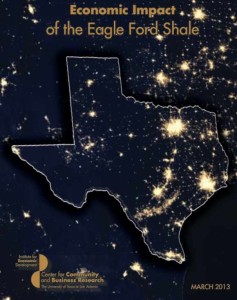Development of oil and natural gas in the Eagle Ford Shale added more than $61 billion in total economic impact during 2012, according to a study released today by the Center for Community and Business Research in The University of Texas at San Antonio Institute for Economic Development. In addition, the region supported 116,000 full-time jobs for workers in oil and gas, drilling, support operations, pipeline construction, refineries and petrochemicals.
Fiscal impacts to the State of Texas are significant. The Eagle Ford added more than two billion dollars in state and local revenue to government coffers in 2012. The continued robust activity in the Eagle Ford stems in large measure from the play’s ability to produce not only natural gas, but also oil and condensate.
“In 2008, we saw very little activity in the Eagle Ford shale. Today, it has become one of the most significant oil and gas plays in the country and has generated a tremendous amount of wealth for Texas,” said Thomas Tunstall, director of the UTSA Center for Business and Community Research, and the study’s principal investigator. “Over the next 10 years, the annual revenue generated and jobs created will continue the steady progress upward, helping to ensure environmental and economic goals can be realized together. The goal is to create sustainable growth for the region.”
Highlights of the UTSA study concluded that shale development:
- generated $61 billion and 116,000 jobs for the 20-county region in 2012
- will generate $89 billion and 127,000 jobs for the 20-county region in 2022;
- added more than $1 billion in total local government revenue in 2012;
- provided $1.2 billion in estimated State revenue in 2012.
UTSA scholars examined the region’s 14 oil and natural gas-producing counties (Atascosa, Bee, DeWitt, Dimmit, Frio, Gonzales, Karnes, La Salle, Live Oak, Maverick, McMullen, Webb, Wilson and Zavala) and the six surrounding counties which serve as staging areas for the oil and gas play. The latter include Bexar and Uvalde Counties as well as Victoria, Jim Wells, Nueces and San Patricio Counties. These supporting counties have seen significant employment growth. For example, Bexar County jobs supported by the shale now exceed 20,000, up from less than 5,000 in 2011.
The study reflects a major surge in Eagle Ford related activity in 2012 as previously announced investments came on line for production, regional headquarter operations, pipelines, rail, supply, services, housing and logistics infrastructure. Early movers continue to consolidate their positions for the long term, notably along the Gulf Coast with new refining and manufacturing investments. The versatility of Eagle Ford was also demonstrated in response to commodity prices, with significant shifts from gas to oil while maintaining high output growth.
About the Center for Community and Business Research at UTSA
The Center for Community and Business Research in the UTSA Institute for Economic Development conducts primary research on community and business development in South Texas and the border region. In addition to the study released today, the Center has published Economic Impact of the Eagle Ford Shale (May 2012), Strategic Housing Analysis (July 2012, in partnership with the UTSA College of Architecture and UTSA Center for Urban and Regional Planning Research), Eagle Ford Shale Impact for Counties with Active Drilling (October 2012) and its Workforce Analysis for the Eagle Ford Shale (October 2012).
"The research conducted at UTSA provides us with valuable information, findings and recommendations related to the Eagle Ford Shale and its impact on Texas' economy," said Senator Judith Zaffirini, D-Laredo. "This research is a wonderful resource not only for state policymakers and business leaders, but also for all stakeholders who are working to create sustainable communities throughout the shale region. Equally important, it underscores the critical role of the higher education community in public service and economic development."
For more information about the Center, visit www.ccbr.iedtexas.org. The full study will be available to the public at 3 p.m. on March 28th. Join the conversation on Twitter (#utsaeagleford).
About UTSA
The University of Texas at San Antonio is one of the largest of nine academic universities and six health institutions in the UT System. As a multicultural institution of access and excellence, UTSA aims to be a national research university providing access to educational excellence and preparing citizen leaders for the global environment.
UTSA serves nearly 31,000 students in more than 135 degree programs in the colleges of Architecture, Business, Education and Human Development, Engineering, Liberal and Fine Arts, Public Policy, Sciences and the Honors College, University College and Graduate School. Founded in 1969, UTSA is an intellectual and creative resource center and a socioeconomic development catalyst for Texas and beyond. Learn more at www.utsa.edu.
The article above was published through EagleFordShale.com’s press release distribution service. Learn more about Eagle Ford Advertising Here.

